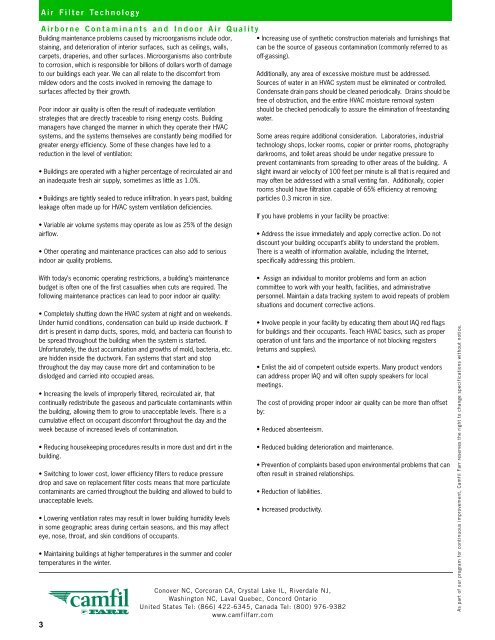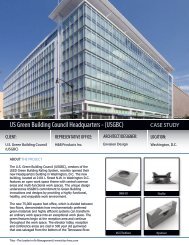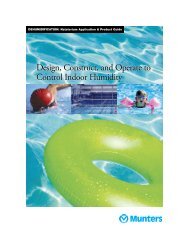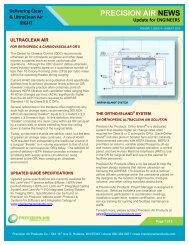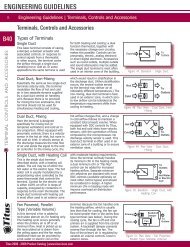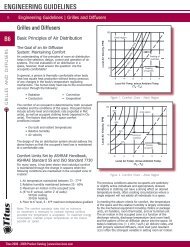Camfil Farr Product Catalog - Texas Air Products
Camfil Farr Product Catalog - Texas Air Products
Camfil Farr Product Catalog - Texas Air Products
You also want an ePaper? Increase the reach of your titles
YUMPU automatically turns print PDFs into web optimized ePapers that Google loves.
3<br />
<strong>Air</strong> Filter Technology<br />
<strong>Air</strong>borne Contaminants and Indoor <strong>Air</strong> Quality<br />
Building maintenance problems caused by microorganisms include odor,<br />
staining, and deterioration of interior surfaces, such as ceilings, walls,<br />
carpets, draperies, and other surfaces. Microorganisms also contribute<br />
to corrosion, which is responsible for billions of dollars worth of damage<br />
to our buildings each year. We can all relate to the discomfort from<br />
mildew odors and the costs involved in removing the damage to<br />
surfaces affected by their growth.<br />
Poor indoor air quality is often the result of inadequate ventilation<br />
strategies that are directly traceable to rising energy costs. Building<br />
managers have changed the manner in which they operate their HVAC<br />
systems, and the systems themselves are constantly being modified for<br />
greater energy efficiency. Some of these changes have led to a<br />
reduction in the level of ventilation:<br />
• Buildings are operated with a higher percentage of recirculated air and<br />
an inadequate fresh air supply, sometimes as little as 1.0%.<br />
• Buildings are tightly sealed to reduce infiltration. In years past, building<br />
leakage often made up for HVAC system ventilation deficiencies.<br />
• Variable air volume systems may operate as low as 25% of the design<br />
airflow.<br />
• Other operating and maintenance practices can also add to serious<br />
indoor air quality problems.<br />
With today’s economic operating restrictions, a building’s maintenance<br />
budget is often one of the first casualties when cuts are required. The<br />
following maintenance practices can lead to poor indoor air quality:<br />
• Completely shutting down the HVAC system at night and on weekends.<br />
Under humid conditions, condensation can build up inside ductwork. If<br />
dirt is present in damp ducts, spores, mold, and bacteria can flourish to<br />
be spread throughout the building when the system is started.<br />
Unfortunately, the dust accumulation and growths of mold, bacteria, etc.<br />
are hidden inside the ductwork. Fan systems that start and stop<br />
throughout the day may cause more dirt and contamination to be<br />
dislodged and carried into occupied areas.<br />
• Increasing the levels of improperly filtered, recirculated air, that<br />
continually redistribute the gaseous and particulate contaminants within<br />
the building, allowing them to grow to unacceptable levels. There is a<br />
cumulative effect on occupant discomfort throughout the day and the<br />
week because of increased levels of contamination.<br />
• Reducing housekeeping procedures results in more dust and dirt in the<br />
building.<br />
• Switching to lower cost, lower efficiency filters to reduce pressure<br />
drop and save on replacement filter costs means that more particulate<br />
contaminants are carried throughout the building and allowed to build to<br />
unacceptable levels.<br />
• Lowering ventilation rates may result in lower building humidity levels<br />
in some geographic areas during certain seasons, and this may affect<br />
eye, nose, throat, and skin conditions of occupants.<br />
• Maintaining buildings at higher temperatures in the summer and cooler<br />
temperatures in the winter.<br />
Conover NC, Corcoran CA, Crystal Lake IL, Riverdale NJ,<br />
Washington NC, Laval Quebec, Concord Ontario<br />
United States Tel: (866) 422-6345, Canada Tel: (800) 976-9382<br />
www.camfilfarr.com<br />
• Increasing use of synthetic construction materials and furnishings that<br />
can be the source of gaseous contamination (commonly referred to as<br />
off-gassing).<br />
Additionally, any area of excessive moisture must be addressed.<br />
Sources of water in an HVAC system must be eliminated or controlled.<br />
Condensate drain pans should be cleaned periodically. Drains should be<br />
free of obstruction, and the entire HVAC moisture removal system<br />
should be checked periodically to assure the elimination of freestanding<br />
water.<br />
Some areas require additional consideration. Laboratories, industrial<br />
technology shops, locker rooms, copier or printer rooms, photography<br />
darkrooms, and toilet areas should be under negative pressure to<br />
prevent contaminants from spreading to other areas of the building. A<br />
slight inward air velocity of 100 feet per minute is all that is required and<br />
may often be addressed with a small venting fan. Additionally, copier<br />
rooms should have filtration capable of 65% efficiency at removing<br />
particles 0.3 micron in size.<br />
If you have problems in your facility be proactive:<br />
• Address the issue immediately and apply corrective action. Do not<br />
discount your building occupant’s ability to understand the problem.<br />
There is a wealth of information available, including the Internet,<br />
specifically addressing this problem.<br />
• Assign an individual to monitor problems and form an action<br />
committee to work with your health, facilities, and administrative<br />
personnel. Maintain a data tracking system to avoid repeats of problem<br />
situations and document corrective actions.<br />
• Involve people in your facility by educating them about IAQ red flags<br />
for buildings and their occupants. Teach HVAC basics, such as proper<br />
operation of unit fans and the importance of not blocking registers<br />
(returns and supplies).<br />
• Enlist the aid of competent outside experts. Many product vendors<br />
can address proper IAQ and will often supply speakers for local<br />
meetings.<br />
The cost of providing proper indoor air quality can be more than offset<br />
by:<br />
• Reduced absenteeism.<br />
• Reduced building deterioration and maintenance.<br />
• Prevention of complaints based upon environmental problems that can<br />
often result in strained relationships.<br />
• Reduction of liabilities.<br />
• Increased productivity.<br />
As part of our program for continuous improvement, <strong>Camfil</strong> <strong>Farr</strong> reserves the right to change specifications without notice.


